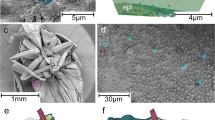Summary
The histological and ultrastructural organisation of the epidermal sensory organs in Amphibolurus barbatus has been described with respect to their position and possible functions. The sensory organs, located at the scale's edge, are most numerous in scales of the dorsal surface of the head. Most other scales of the body surface have two receptors located laterally to the spine or keel of the scale. In the imbricate scales of the ventral body region, the receptors lie just beneath the reinforced scale lip. Scanning electron microscopy has revealed the surface of the organ to be a crater lacking any surface projections. These sensory organs have a dermal papilla consisting of a nerve plexus and loose connective tissue. The nerve fibres arising from the plexus, pass to the epidermal columnar cells, where some form nerve terminals at the base of the cells, while others pass between them to form nerve terminals embedded in a superficial layer of cuboidal cells. The superficial terminals are held against the overlying α keratin by masses of tonofilaments. The β keratin is thickened to form a collar around the periphery of the organ but is only about 0.5 μm thick immediately above it. Mechanical deformation of the scale's spine or reinforced scale lip may initiate stimulation of the nerve terminals described.
Similar content being viewed by others
References
Aota S (1940) An histological study of the integument of a blind snake, Tuphlops braminus (Daudin) with special reference to the sense organs and nerve ends. J Sci Hiroshima Univ Ser B 7:193–208
Cohn L (1914) Die Hautsinnesorgane von Agama colonorum. Zool Anz 44:145–155
Düring M von (1973a) Zur Feinstruktur der intraepidermalen Nervenfasern von Nattern (Natrix). Z Anat Entwickl.-Gesch 141:339–350
Düring M von (1973b) The ultrastructure of lamellated mechanoreceptors in the skin of reptiles. Z Anat Entwickl.-Gesch 143:81–94
Düring M von (1974) The radiant heat receptor and other tissue receptors in the scales of the upper jaw of Boa constrictor. Z Anat Entwickl.-Gesch 145:299–319
Düring M von, Miller MR (1979) Sensory nerve endings of the skin and deeper structures. In: Gans C (ed) Biology of the Reptilia. Academic Press, London New York San Francisco
Grandison AGC (1968) Nigerian lizards of the genus Agama (Sauria: Agamidae). Bull Br Mus Natl Hist (Zool) 17:65–90
Hiller U (1976a) Elektronenmikroskopische Untersuchungen zur funktioneilen Morphologie der borstenführenden Hautsinnesorgane bei Tarentola mauritanica L. (Reptilia, Gekkonidae). Zoomorphologie 84:211–221
Hiller U (1976b) Ultrastruktur und Regeneration mechanorezeptiver Hautsinnesorgane bei Gekkoniden. Naturwissenschaften 63:200–201
Hiller U (1977) Structure and position of receptors within scales bordering the toes of Gekkonids. Cell Tissue Res 177:325–330
Jaburek L (1926) Über Nervenendigungen in der Epidermis der Reptilien. Z Mikr-Anat Forsch 10:1–49
Jackson MK (1971) Cutaneous sense organs on the heads of some small ground snakes in the genera Leptotyphlops, Tantilla, Sonora and Virginia (Reptilia: Serpentes). Am Zool 11:707–708
Jackson MK (1976) Histology and distribution of cutaneous touch corpuscles in some leptotyphlopid and colubrid snakes (Reptilia, serpentes). J Herpetol 11:7–15
Jackson MK, Doetsch GS (1977) Functional properties of nerve fibers innervating cutaneous corpuscles within cephalic skin of the Texas rat snake. J Exp Neurol 56:63–77
Landmann L (1975) The sense organs in the skin of the head of Squamata (Reptilia). Isr J Zool 24 (3/4):99–135
Landmann L, Villiger W (1975) Glycogen in epidermal nerve terminals of Lacerta sicula (Squamata: reptilia). Experientia 31 (8):967–968
Maderson PFA (1965) Histological changes in the epidermis of snakes during the sloughing cycle. J Zool 146:98–113
Miller MR, Kasahara M (1967) Studies on the cutaneous innervation of lizards. Proc Calif Acad Sci (4) 34:549–568
Proske U (1969a) Nerve endings in the skin of the Australian black snake. Anat Rec 164:259–266
Proske U (1969b) An electrophysiological analysis of cutaneous mechanoreceptors in a snake. Comp Biochem Physiol 29:1039–1046
Proske U (1969c) Vibration-sensitive mechanoreceptors in snake skin. Exp Neurol 23:187–194
Schmidt WJ (1917) Studien am Integument der Reptilien VIII. Über die Haut der Acrochordinen. Zool Jb Abt Anat Ontog Tier 40:155–202
Schmidt WJ (1918) Allgemeine Bemerkungen über die Hautsinnesorgane der Schlangen. In: Studien am Integument der Reptilien VIII. Zool Jahrb Anat u Ont 40:185–200
Schmidt WJ (1920) Einiges über die Hautsinnesorgane der Agamiden insbesondere von Calotes nebst Bemerkungen über diese Organe bei Geckoniden und Iguaniden. Anat Anz 53:113–139
Author information
Authors and Affiliations
Rights and permissions
About this article
Cite this article
Maclean, S. Ultrastructure of epidermal sensory receptors in Amphibolurus barbatus (Lacertilis: Agamidae). Cell Tissue Res. 210, 435–445 (1980). https://doi.org/10.1007/BF00220200
Accepted:
Issue Date:
DOI: https://doi.org/10.1007/BF00220200



